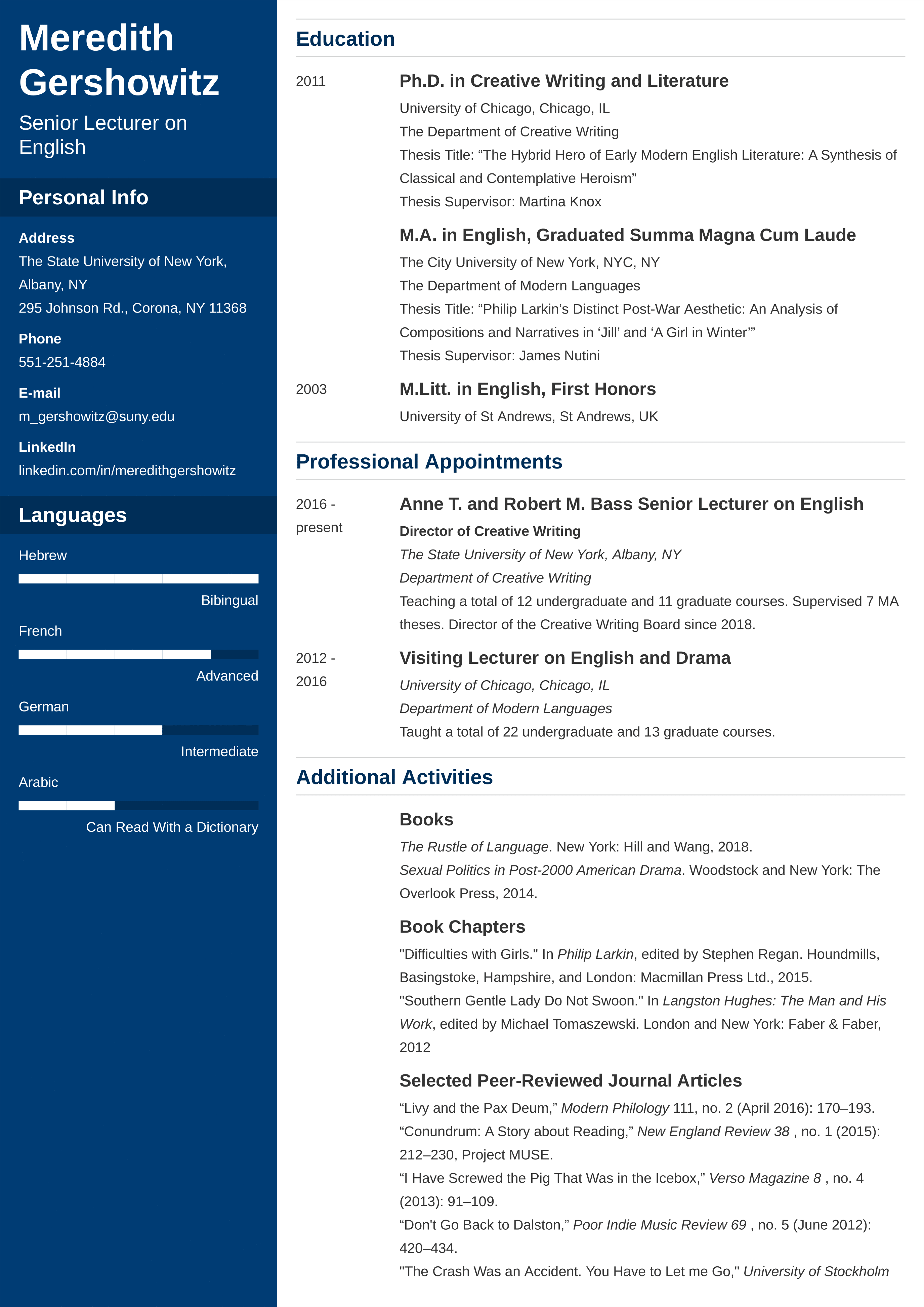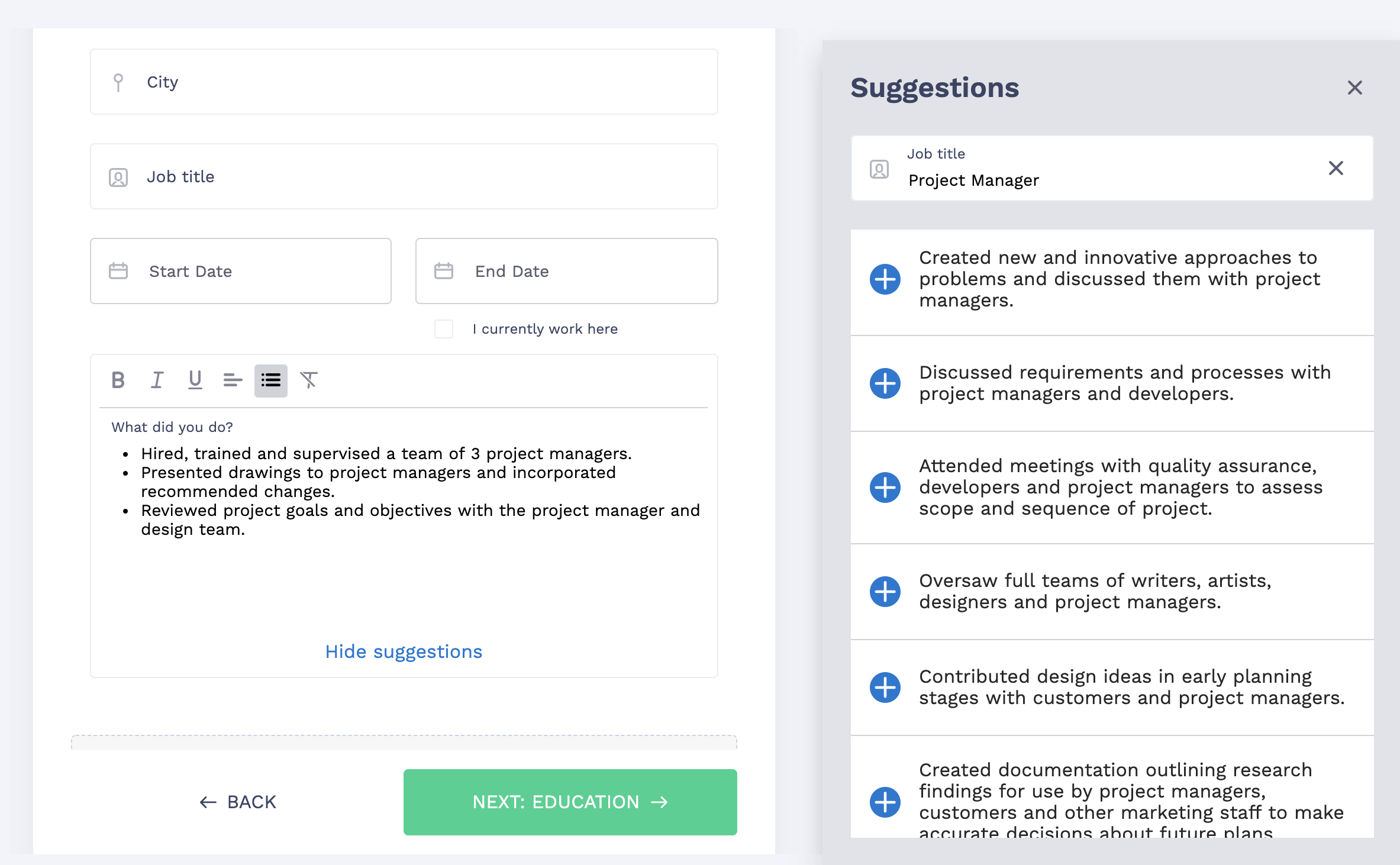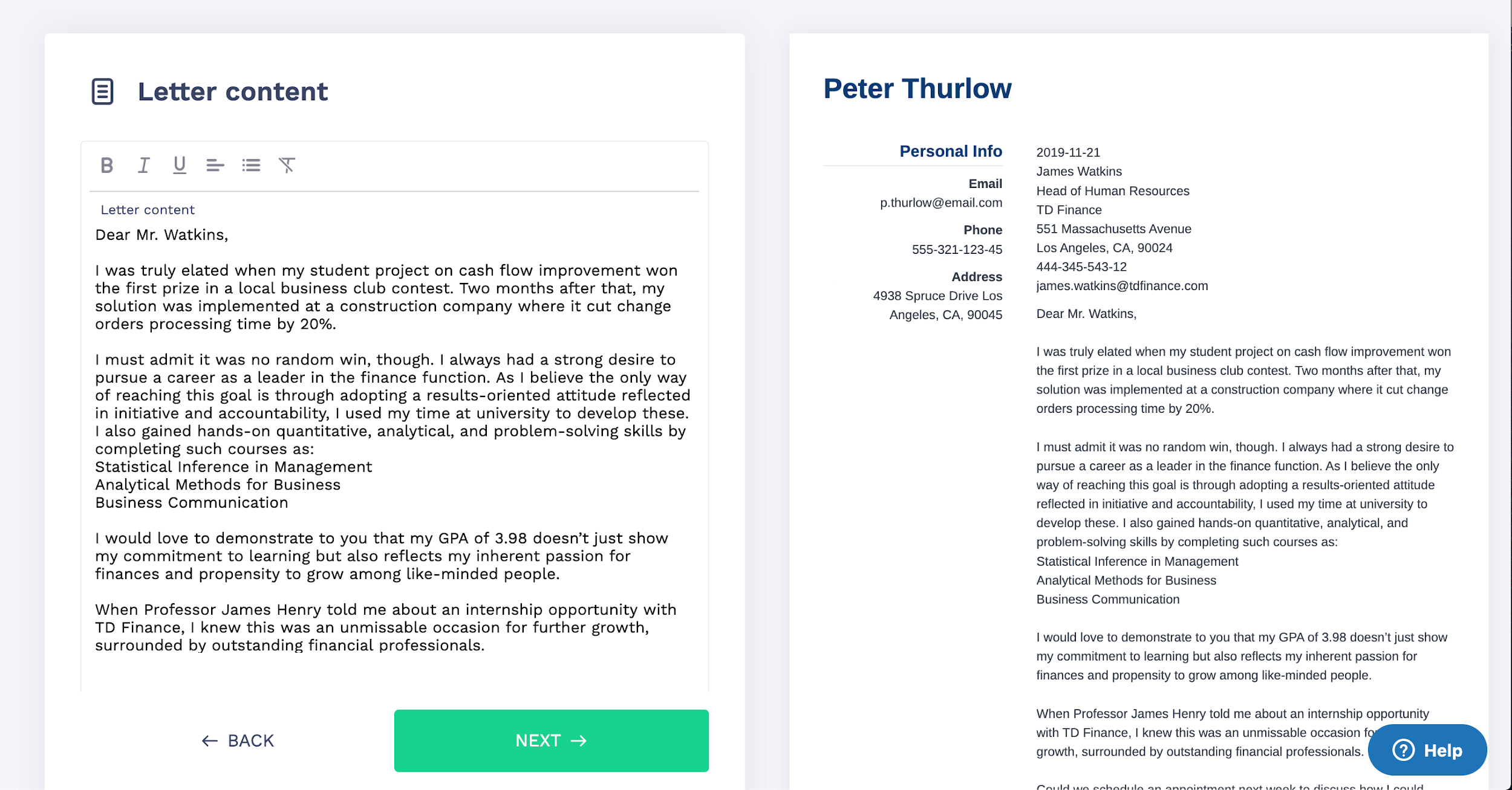
CV for Internship—Sample & 25+ Writing Tips
A CV for internships that’ll get you into the interview. Write your internship CV fast, with expert hints, 25+ writing tips & good and bad examples.

Tom Gerencer
Career Expert
Summary: In this guide, you’ll see a sample academic curriculum vitae and a detailed breakdown of how to write and format each section to make the most of your education and credentials.
Let’s face it, today’s academic realities are pretty harsh.
So many talented scholars fighting for so few truly worthwhile fellowships, research programs, or grants.
And with the 5% cut in federal spending on higher education, things are only going to get worse.
You can’t change the economy, I’m sorry. But you can dramatically boost your chances of standing out from all other applicants.
Just follow the advice from this guide to writing an American academic CV.
First things first. See the below academic CV example for reference.
A Curriculum Vitae (CV) is a document presenting a person's education, publications, and other accomplishments. A CV contains greater detail than a résumé and is generally used when applying for a position in academia.
What does a perfect academic CV look like? See below—
Save hours of work and get a CV like this. Pick a template, fill it in. Quick and easy. Choose from 21 CV templates and download your CV now.

What users say about ResumeLab:
I had an interview yesterday and the first thing they said on the phone was: “Wow! I love your CV.”
Patrick
I love the variety of templates. Good job guys, keep up the good work!
Dylan
My previous CV was really weak and I used to spend hours adjusting it in Word. Now, I can introduce any changes within minutes. Absolutely wonderful!
George
Need help with a different kind of CV? Explore our other guides:
Meredith Gershowitz
CURRICULUM VITAE
2019/01/25
Meredith Gershowitz
Senior Lecturer on English
Director of Creative Writing
The State University of New York, Albany, NY
295 Johnson Rd., Corona, NY 11368
551-251-4884
m_gershowitz@suny.edu
linkedin.com/in/meredithgershowitz
EDUCATION
2011 Ph.D. in Creative Writing and Literature
University of Chicago, Chicago, IL
The Department of Creative Writing
Thesis Title: “The Hybrid Hero of Early Modern English Literature: A Synthesis of Classical and Contemplative Heroism”
Thesis Supervisor: Martina Knox
2004 M.A. in English, Graduated Summa Magna Cum Laude
The City University of New York, NYC, NY
The Department of Modern Languages
Thesis Title: “Philip Larkin’s Distinct Post-War Aesthetic: An Analysis of Compositions and Narratives in ‘Jill’ and ‘A Girl in Winter’”
Thesis Supervisor: James Nutini
2003 M.Litt. in English, First Honours
University of St Andrews, St Andrews, UK
PROFESSIONAL APPOINTMENTS
Anne T. and Robert M. Bass Senior Lecturer on English
Director of Creative Writing
The State University of New York, Albany, NY
Department of Creative Writing
2016–
Teaching a total of 12 undergraduate and 11 graduate courses. Supervised 7 MA theses. Director of the Creative Writing Board since 2018.
Visiting Lecturer on English and Drama
University of Chicago, Chicago, IL
Department of Modern Languages
2012–2016
Taught a total of 22 undergraduate and 13 graduate courses.
PUBLICATIONS
Books
The Rustle of Language. New York: Hill and Wang, 2018.
Sexual Politics in Post-2000 American Drama. Woodstock and New York: The Overlook Press, 2014.
Book Chapters
"Difficulties with Girls." In Philip Larkin, edited by Stephen Regan. Houndmills, Basingstoke, Hampshire, and London: Macmillan Press Ltd., 2015.
"Southern Gentle Lady Do Not Swoon." In Langston Hughes: The Man and His Work, edited by Michael Tomaszewski. London and New York: Faber & Faber, 2012
Selected Peer-Reviewed Journal Articles
“Livy and the Pax Deum,” Modern Philology 111, no. 2 (April 2016): 170–193.
“Conundrum: A Story about Reading,” New England Review 38, no. 1 (2015): 212–230, Project MUSE.
“I Have Screwed the Pig That Was in the Icebox,” Verso Magazine 8, no. 4 (2013): 91–109.
“Don't Go Back to Dalston,” Poor Indie Music Review 69, no. 5 (June 2012): 420–434.
"The Crash Was an Accident. You Have to Let me Go," University of Stockholm Press 18 (March 2011): 37–53.
Other Publications
“The Prophet of Dystopia.” New Yorker, April 17, 2017.
“Snap Makes a Bet on the Cultural Supremacy of the Camera.” New York Times, March 8, 2014. https://www.nytimes.com/this-is-a-fake-url/technology/snap-makes-a-bet-on-the-cultural-supremacy-of-the-camera.html.
“The Squishy, Sugary History of Peeps.” Vox, April 11, 2012. http://www.vox.com/culture/fake-url-everybody/3012/4/11/15209084/peeps-easter.
AWARDS AND HONORS
2018, National Humanities Medal
2018, Ruskin Society Book Prize, Winner
2017 PROSE Award for Textbook/Best in Social Sciences, Honourable Mention
2015, Choice Outstanding Academic Title, Winner
2011, PROSE Award for Single Volume Reference in the Humanities and Social Sciences, Honourable Mention
2003, Fulbright / The City University of New York Award in Humanities
CONFERENCES
2018, The Limits of an Institution, International Conference, Universidad Complutense, Madrid, Spain; Paper title: "New York City's Art Museums and Activism: The Evolving Relationship."
2017, Prophecy or Randomness, The City University of New York, New York, NY; Paper title: “Carrie Ligon and the Questions of Identity.”
2016, Conflicting Futures, Lee Hansley Institute, Raleigh, NC; Paper title: “A Story About Space: Questioning Terry Eagleton’s Critique Methods.”
TEACHING EXPERIENCE
Teaching Assistant
University of Chicago, Chicago, IL
2005–2011
Teaching Assistant
The City University of New York, NYC, NY
LANGUAGES
Hebrew: Bilingual
French: Advanced
German: Intermediate
Arabic: Can Read With a Dictionary
If you’re applying for a scholarship and have been asked specifically to send a scholarship academic CV instead of a CV, see: Scholarship CV Examples and Writing Tips
Still a student? Writing an academic CV for school admissions or internships? Switch over to: Student CV Examples and Writing Tips
Read on for an overview of an American CV for academic purposes. But before we jump into that, a quick note—
Academic CVs vary in content, chief focus, and length.
Obviously, a CV for graduate school won’t have all the sections a professor's CV has. A research CV for scientists will highlight other sorts of achievements than an academic teacher CV.
There’s no one-size-fits-all template.
This guide’s purpose is to provide you with basic concepts and rules every academic curriculum vitae has to follow.
Before you even start writing, take your time to properly format your academic CV, . Admission committees and other academic decision makers can be truly nit-picky when it comes to details. So—
Make sure your CV is scholarly and elegant. Avoid amateurish gaffes that would make you look like a rookie.
Expert Hint: After you finish writing, save your Academic CV in PDF to keep formatting intact. The only exception is when the institution to which you’re applying only accepts academic CVs in Word. Unsure about that? Shoot a quick email or make a phone call and ask to stay on the safe side.
Now—
What goes where on a professional academic curriculum vitae?
Don’t have all of the above?
If you’re, say, writing a graduate student CV or even an undergraduate student CV, applying for a PhD, or seeking to get a part-time research assistant gig your at your campus, don’t worry.
Just skip those sections where you haven’t earned any experience yet. You’ll get there in a few years!
When it comes to outlining your academic CV, there’s one rule that never changes:
Education is always at the top, just below the header with your contact information.
Below that, you organise sections by competitiveness.
The more prestigious the accolade, credential, or achievement, the higher you place it.
But remember that academic CVs might vary depending on the type of position or program you’re targeting.
What exactly are you applying for?
An academic research CV for scientific grants should highlight research over teaching. A PhD candidate academic CV will have a more elaborate education section, while a postdoc CV will emphasise publications.
In other words: the template above works as a universal reference point, but feel free to adjust it so that it fits your specific needs.
Time to break down how to create each section of your curriculum vitae for greatest impact.
Expert Hint: Adding a LinkedIn profile address is also optional. Do so if you’re active on LinkedIn and your profile is up-to-date. Business and science scholars tend to add a LinkedIn handle more often.
The ResumeLab builder is more than looks. Get specific content to boost your chances of getting the job. Add job descriptions, bullet points, and skills. Easy. Improve your CV in our CV builder now.

Nail it all with a splash of colour, choose a clean font, highlight your skills in just a few clicks. You’re the perfect candidate and we’ll prove it. Use the ResumeLab builder now.
For experienced researchers and lecturers, this part is redundant.
Add a personal profile on your CV only if asked for in the guidelines of the institution you’re applying to. Undergrad CVs for grad school applications might benefit from this section.
Here’s how to write it:
BA graduate in Psychology at Anytown University with a one-year study abroad experience at the Padua University and three semesters of experience assisting on-campus research projects. Made the Dean’s List for three years. Seeking to undertake doctoral research on Educational Psychology and Applied Developmental Science.
List your institutions chronologically descending.
Include, in the following order:
No further details required.
You might include your thesis title and supervisor, but that’s about as elaborate as you might get here.
2004 M.A. in English, Graduated Summa Magna Cum Laude
The City University of New York, NYC, NY
The Department of Modern Languages
Thesis Title: “Philip Larkin’s Disting Post-War Aesthetic: An Analysis of Compositions and Narratives in ‘Jill’ and ‘A Girl in Winter’”
Thesis Supervisor: James Nutini
Expert Hint: Spelling out “Doctor of Philosophy,” or “Master of Science” will make you come across pretentious. As if you had that printed on your doorplate (you don’t, do you?).
Remember: on an adjunct professor CV or CV, there’s usually no place for this section.
Only contracted tenure goes here. And, only stints of 1+ year employment. List other types of teaching experience in the, well, “Teaching Experience” section below.
If you have had professional appointments (congratulations on your big break!), limit yourself to the following necessary details only:
Like in every other academic curriculum vitae section, use the reverse-chronological order.
Visiting Lecturer on English and Drama
University of Chicago, Chicago, IL
Department of Modern Languages
2012–2016
Taught a total of 22 undergraduate and 13 graduate courses.
Expert Hint: I want to stress it so hard it causes mental fatigue: don’t use bullet points here. Or anywhere else. This. Is. Not. A. CV.
Stick to one standard citation style (APA, MLA, or Chicago).
Organise publications by volume, peer-review and prestige:
This part has gotten all the more important recently.
Considering the planned heavy cuts on federal spendings on higher ed, your academic CV needs to prove that your research so far has been valuable enough to attract funding.
Expert Hint: Add the grants or scholarships you have rejected as well. You’re still a legitimate recipient. This is particularly important in artist CVs or CVs for fellowship applications.
Especially invited talks outside of your campus.
Why?
In a word: competitiveness.
To get an invite to do a talk on another campus is insanely prestigious.
Not saying there’s anything wrong with TAing or RAing but, let’s face it, all PhD students, let alone postdoc scholars, have done it at some point in their careers.
But—
If you’re writing a junior academic CV for research projects or a part-time academic teacher CV, you might want to consider pulling your research/teaching experience above conference talks.
Always think about your target audience and what they expect from you.
Languages are a must. Describe all languages you know well enough to read basic academic texts in them. You can use the IRL scale (1, 2, 3, 4, 5), CEFR (A1, A2, B1, B2, C1, C2) or go for descriptive evaluation (basic, intermediate, advanced, native).
Listing skills is customary for technical fields such as computer science or engineering.
References are included on an academic CV only if explicitly asked for. You enter them at the very bottom. No need to explain your relationship with a reference unless you’re writing a CV for an undergraduate and only have one reference.
Double your impact with a matching CV and cover letter combo. Use our cover letter builder and make your application documents pop out.

Want to try a different look? There’s 18 more. A single click will give your document a total makeover. Pick a cover letter template here.
Here’s a recap of what’s most important in producing an Academic CV, regardless of your field and seniority level:
Questions? Concerns? I’m here to listen and assist. Drop me a line in the comments and I’ll make sure to get back to you straight away!
At ResumeLab, excellence lies at the heart of our values, underpinning our promise to provide outstanding career resources. Our team of career experts meticulously assesses each article in line with our editorial guidelines, guaranteeing our content's high quality and dependability. We consistently engage in original research, illuminating the nuances of the job market and earning acclaim from various influential news outlets. Our commitment to delivering professional career advice draws millions of readers to our blog annually.

A CV for internships that’ll get you into the interview. Write your internship CV fast, with expert hints, 25+ writing tips & good and bad examples.

Tom Gerencer
Career Expert

Admission counsellors are on the lookout for well-rounded candidates. Show them you’re diverse with accomplishments and extracurriculars in a jaw-dropping graduate school CV.

Roger Maftean
Career Expert

Land of the brave, home of the free. You’re free to do as you like here! Apart from the US CV format. Turns out Americans are pretty attached to it.

Dave Rygielski
Career Expert